In this section, the algorithms of five highly effective methods used for numerical analysis in the QURAN will be explained. Some strong examples (data) obtained through these methods will also be presented in the book. Although our database contains a large amount of data, we have decided to select and present only the strongest evidences – the kind that minimizes objections and challenges non-believers the most – which is why the book includes a limited number of examples. A careful researcher will easily recognize that such data could not possibly emerge from a single book. Additionally, there are other very strong evidences beyond what is presented in this book; however, these are planned to be included in other books of the series. The number of examples in the book has been kept limited to avoid discouraging some readers due to excessive length.
The methodology presented here is a comprehensive and general one, and many pieces of evidence have been derived using all the methods described within it. Before moving on to the data derivation algorithms, the procedures followed regarding the Mushaf will be explained.
Procedures Regarding the Mushaf
In the analyses, the Hafs ‘an ‘Asim recitation has been taken as the basis for the Mushaf. Over 90% of Muslims worldwide recite the QURAN using this recitation. Additionally, the Warsh recitation is preferred in some North African countries; however, in terms of global prevalence, the Hafs ‘an ‘Asim recitation is the most widespread, which is why it has been adopted as the standard in this book.
Note: All recitations are valid and have been divinely revealed.
When counting the number of letters in any word or section, the written form (orthography) of the text has been taken as the basis. In some cases, the number of letters pronounced may differ from the number of letters written. We would like to provide some examples in English. Consider the English word “George.” It is written with 6 letters, but when pronounced, it is articulated as “Jorj”, which consists of 4 letters.
Thus, languages have their intricacies, and to avoid such discrepancies, only the written form (orthography) of words has been used for counting. In other words, the number of letters in a word has been determined based on how it is written. As a general rule, it can be stated:
“In this book, letter counts are based on the written form (orthography) of words.”
Today, computer programs also follow this method for letter counting. For example, if an English text is to be counted in Microsoft Word, the program counts based on the written form and does not consider pronunciation. We have conducted our counts with the same programmatic logic. After all, the statistical program we use is, as the name suggests, a computer program and performs counts just like Microsoft Word.
Throughout the book, a link to the counting program used in the analyses will be shared here so that interested readers can perform their own counts. The name of the program is:
برنامج إحصاء القرآن
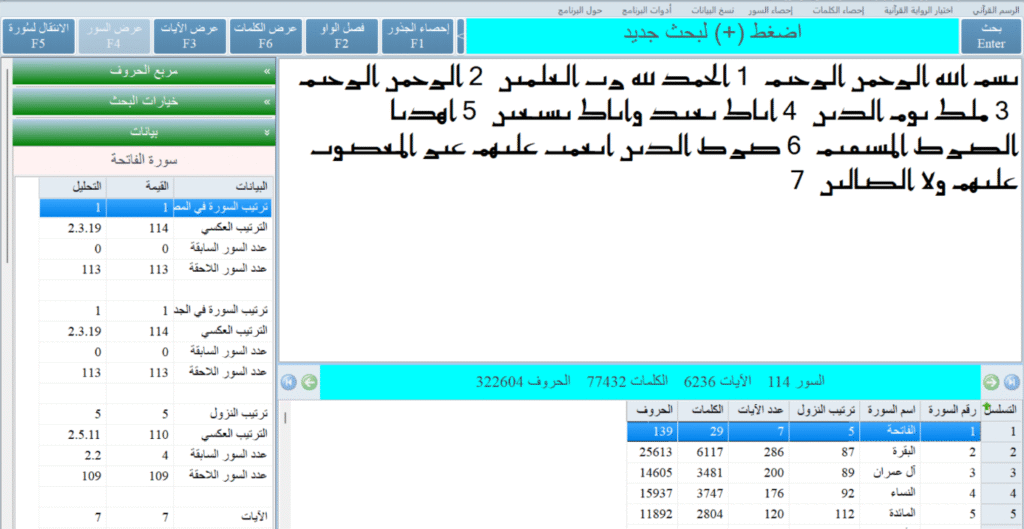
The program used is based on the Hafs ‘an ‘Asim recitation. This program was created by digitizing the Mushaf of Medina, which is printed in Saudi Arabia and widely recognized today. It enables all conceivable types of counting.
The Fundamental Values of the QURAN
- The QURAN consists of 114 Surahs.
- The number of verses (Ayahs) in the QURAN is 6,236.
- The number of words in the QURAN is 77,432.
- The number of letters in the QURAN is 326,159.
The count of 6,236 verses has been narrated from Hz. Ali (r.a.), known as the “Gate of Knowledge,” and Abdullah ibn Abbas (r.a.), who was given the title “Hibr al-Ummah” (The Scholar of the Ummah) and for whom the Prophet (a.s.) made prayers such as “O Allah, teach him the interpretation of the Quran.” This counting method is also known as the Kufa school (recitation tradition).
In this counting method:
- The Basmalah (بِسْمِ اللَّهِ الرَّحْمَٰنِ الرَّحِيمِ) at the beginning of Surah Al-Fatihah is included in the verse count.
- However, the Basmalahs at the start of other Surahs are not counted as separate verses. Instead, they are marked as “Verse 0,” and the subsequent verses are numbered 1, 2, 3, 4, 5, 6… and so on.
The program used for counting letters and words follows the same logic as standard computer programs. This means that those who wish to verify the counts can transfer the Mushaf text into Microsoft Word and perform the counts themselves to confirm the results.
Note: When counting words in the QURAN, the letter “Waw” (و) is considered attached to the following word and is not counted as a separate word. This is also the consensus (Ijma’) of Arabic linguists.
Regarding the Letter Count (326,159)
As explained earlier, the total letter count of the QURAN is 326,159, based on the Hafs ‘an ‘Asim recitation—the most widespread recitation in the world. Hamzas (ء) are also counted as letters because they are part of the word’s original structure.
Examples:
- The word “bina’un” (بِنَاءٌ) is written without Hamza as بنا (3 letters) but with Hamza as بناء (4 letters). If the Hamza is not counted, the “un” sound is lost.
- Similarly, the word “sama’un” (سَمَاءٌ) is written without Hamza as سما (3 letters) but with Hamza as سماء (4 letters). Again, excluding the Hamza would omit the “un” sound.
Since Hamza is one of the most intricate topics in Arabic grammar and requires expertise, detailed explanations will not be provided here to avoid overwhelming the reader. However, for the reasons explained above, Hamzas are included in the letter count – and rightfully so.
The count of 326,159 letters is based on including Hamzas. The Medina Mushaf printed in Saudi Arabia today includes Hamzas, and the counting program used is an exact digital copy of this Mushaf.
A Possible Question and Its Answer
Some may ask:
“During the time of Hz. Uthman (r.a.), the Mushafs did not have Hamzas. So why do we count them now?”
The answer is:
During Hz. Uthman’s time, the Arabic language was in its simplest form – without diacritics (harakat), punctuation, or spelling marks. The development of Arabic grammatical rules began during the era of Hz. Ali (r.a.), the son-in-law of the Prophet (a.s.). Later, diacritics, dots, and other symbols were added to the Mushafs to preserve the correct recitation of the QURAN. This was necessary, as failing to do so would have led to catastrophic misreadings.
An Example for Clarity:
Imagine Turkish written in the past without any punctuation marks and only in Latin letters. Suppose there were no diacritics at all. In such a case, the word “oldu” meaning ‘’could be’’ read as “öldü” (meaning “he died”). This example illustrates how critical and necessary these markings were.
The addition of diacritics to Quranic letters was inspired by Allah (سُبْحَانَهُ وَتَعَالَى) as a means of preserving the correct recitation of the QURAN. The following verse serves as evidence for this matter:
[Quran 75:17]
إِنَّ عَلَيْنَا جَمْعَهُ وَقُرْآنَهُ
“Surely upon Us is its collection and its recitation.”
As seen, Allah (سُبْحَانَهُ وَتَعَالَى) is essentially saying:
“Do not worry. The compilation of the Quran, the preservation of its text, and the safeguarding of its recitation are all under MY control.” This verse brings peace to the believers.
The addition of diacritics (harakat), punctuation marks, and Hamzas to the Mushafs after the era of Hz. Uthman (r.a.) demonstrates the manifestations of this verse. If these markings had not been added to the Mushafs, as explained earlier, it would have led to a complete disaster, and the Quran’s wording would have been misread by people.
At this point, a reader might wonder:
“But Allah (سُبْحَانَهُ وَتَعَالَى) has taken upon Himself the preservation, compilation, and recitation of the Quran—yet diacritics, punctuation, and Hamzas were added to the Mushafs by humans?”
This simple question can be answered as follows:
Everything that occurs in the universe happens by the will of Allah (سُبْحَانَهُ وَتَعَالَى). The following verse explains this matter perfectly:
[Quran 8:17]
فَلَمْ تَقْتُلُوهُمْ وَلَٰكِنَّ اللَّهَ قَتَلَهُمْ ۚ وَمَا رَمَيْتَ إِذْ رَمَيْتَ وَلَٰكِنَّ اللَّهَ رَمَىٰ ۚ وَلِيُبْلِيَ الْمُؤْمِنِينَ مِنْهُ بَلَاءً حَسَنًا ۚ إِنَّ اللَّهَ سَمِيعٌ عَلِيمٌ
“You did not kill them, but it was Allah who killed them. And you did not throw when you threw, but it was Allah who threw, so that He might test the believers with a good test from Himself. Indeed, Allah is All-Hearing, All-Knowing.”
This verse declares that although the Prophet (a.s.) physically threw stones in battle, in reality, it was Allah (سُبْحَانَهُ وَتَعَالَى) who threw them. Similarly, while the addition of diacritics, punctuation, and Hamzas to the Mushafs for the preservation of the Quran’s recitation may appear to be the work of humans outwardly, in truth, it was carried out by the will, decree, and inspiration of Allah (سُبْحَانَهُ وَتَعَالَى).
Throughout this book, Allah (سُبْحَانَهُ وَتَعَالَى) has shown us, through overwhelming evidence, that Hamzas must be counted in numerical analyses. For example, cesium and parsec analyses prove that the Quran has been perfectly preserved down to its letters. There are other miracles as well.
How Did Allah Teach Us That Hamzas Must Be Counted?
If someone asks, “How did Allah teach us that Hamzas must be counted?”, the answer is as follows:
[Quran 55:1-2]
الرَّحْمَٰنُ عَلَّمَ الْقُرْآنَ
“The Most Merciful taught the Quran.”
Allah (سُبْحَانَهُ وَتَعَالَى) has shown us such powerful evidence through Quranic numerical analyses that we have come to understand that Hamzas must indeed be counted. This process is somewhat akin to reverse engineering. The existence of perfect and precise miracles in the Quran that only manifest when Hamzas are counted teaches us the rule that Hamzas must be included.
Furthermore, as explained earlier with words like “bina’un” (بِنَاءٌ) and “sama’un” (سَمَاءٌ), the absence of Hamzas leads to the loss of the “un” sound in pronunciation. Therefore, Hamzas must be counted.
Moreover, when readers see how precise, detailed, and accurate the data presented in this book is, they will naturally accept that Hamzas must be counted. Today, thousands of Arabic linguists also agree (Ijma’) that Hamzas should be counted as letters.
The counting program used in the analyses allows for both Hamza-inclusive and Hamza-exclusive counts. Since the Hamza is an inherent and pronounced letter in words, there is nothing more natural than counting it as a letter.
However, if stubborn atheists and deists insist on excluding Hamzas from the count, we respond by saying:
“Without a doubt, significant discoveries have also been made in the Quran using Hamza-exclusive counts.” Here, we will present just a few examples:
In the Quran, there is Surah An-Najm which mentions the star Sirius A, and this is the only place where Sirius A is mentioned by name. The star Sirius A is referred to as “Ash-Shi’ra” in Arabic. The miraculous aspect concerning Sirius A in Surah An-Najm is as follows:
In Surah An-Najm, the word “najm” (النجم), meaning “star,” appears only once in the first verse of the surah. Additionally, in verse 49, which mentions “Ash-Shi’ra” (الشعري), known in modern science as Sirius A, the word “Ash-Shi’ra” appears. If we count the letters from the word “najm” (star) in verse 1 to the word “Ash-Shi’ra” in verse 49 (including both words), the result is truly astonishing. The total number of letters between these two words (inclusive) is exactly 1,190.
When we investigate what connection this number (1,190) has with Sirius A, we find something truly remarkable: the radius of Sirius A is 1,190,300 km, which is approximately 1,190 × 10³ km. This correspondence is astounding.

Thus, in Surah An-Najm, which mentions Sirius A, the number of letters from the word “star” (yıldız) to the word “Sirius A” (Şi’ra) corresponds to the radius value of Sirius A. If the radius of Sirius A is expressed in megameters instead of kilometers – when rounded to the nearest whole number – it equals 1,190 megameters, since one megameter corresponds to 1,000 kilometers. Therefore, it is evident that in Surah An-Najm, through the Hamza-exclusive counting method, an indication is made to the radius of Sirius A.
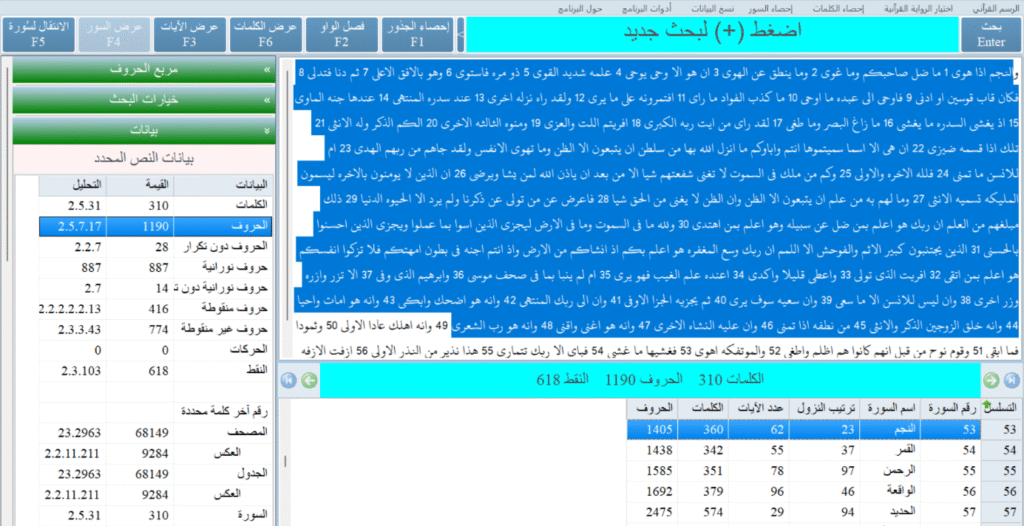
Another example of Hamza-exclusive counting is as follows:
Googol is a very large number used in mathematics and is expressed as follows:
1 googol = 10^100
That is, 1 googol is written by adding 100 zeros after the digit 1:
As can be seen, the number Googol is obtained by writing 100 zeros after the digit 1, and the name Googol is a universal term. In fact, the name of the Google search engine is derived from this word; because the Google search engine thought that only such a large number could represent its vast database.
In the Quran, in verse 4:155, a Googol letter sequence appears, and remarkably, in the Hamza-exclusive count, this verse consists of exactly 100 letters. As explained above, the Googol number is an enormous number obtained by writing 100 zeros after the digit 1, or in other words, it is written as 10^100.
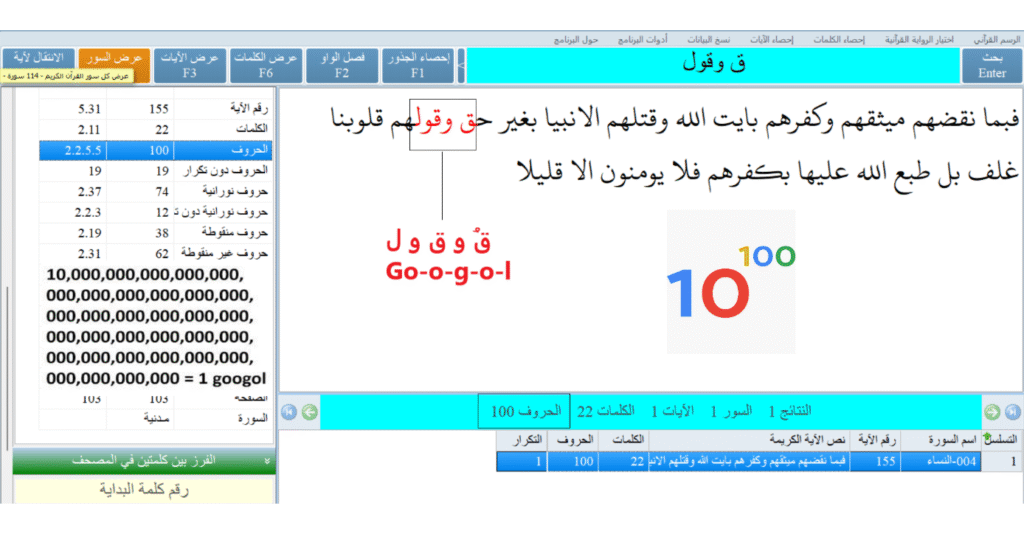
Note: In the above analysis, the letter ق was taken as ‘g’, and some information regarding how this is a common occurrence in Arabic dialects is provided below.
In Arabic, the letter ق (qaf) is pronounced as “g” in some dialects, such as:
1. Egyptian Arabic
- In Egypt, قis usually pronounced as “g” (like in Turkish).
- Example:
- قمر (gamar) → “moon” (in Standard Arabic “qamar”)
- قال (gaal) → “said” (in Standard Arabic “qaal”)
2. Sudanese Arabic
- In Sudan, the letter ق is also pronounced as “g”.
3. Some Dialects of Gulf Arabic
- In the eastern part of Saudi Arabia, and in some regions of Kuwait, Bahrain, and the United Arab Emirates (especially in rural areas), the letter ق is pronounced as “g”.
- Example:
- قلب (galb) → “heart” (in Standard Arabic “qalb”)
4. Bedouin Dialects
- In the deserts of Saudi Arabia, Jordan, Iraq, and Syria, in some Bedouin tribes, the letter ق can shift to the sound “g”.
5. In Some Villages of Lebanon and Syria
Especially in rural areas, the letter قcan be pronounced as “g”.
One of the most important constants in chemistry is Avogadro‘s constant. The definition and value of this constant are as follows:
Avogadro’s Number (Avogadro’s Constant – NANA) Definition
Avogadro’s number is a universal constant that represents the number of fundamental particles (atoms, molecules, ions, etc.) in one mole of a substance. Its exact definition is:
The amount of substance that contains as many elementary entities as there are atoms in 12 grams of carbon-12 isotope is defined as 1 mole. This number is called Avogadro‘s number.
Key Properties:
- Symbol: NA
- Value (according to the 2019 SI definition):
- NA=6.02214076×1023 mol-1
- Purpose:
It serves as a bridge between atomic/molecular-scale particle counts and macroscopic measurements (grams, liters, etc.).
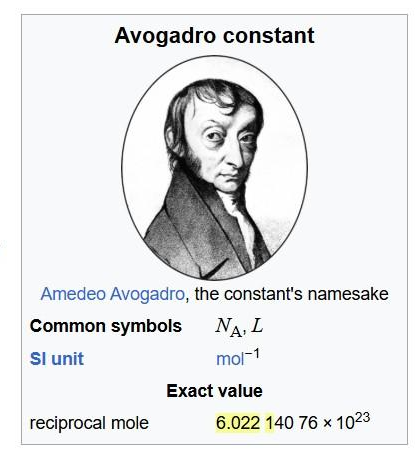
As seen, the name of this constant is a proper noun, ‘Avogadro.’ This means the name of this constant is universal and remains the same or similar in all languages. In the QURAN, the letter sequence ‘Avigadro/Avoigadro,’ which bears an astonishingly close resemblance to this name, appears in Surah Saba as follows:
34:36

This verse holds such a distinct position within the surah that it remarkably points to Avogadro’s constant in a very specific way. Up to this verse, counting from the beginning of the surah, there are 602 words – a significant reference point. Furthermore, within the verse itself, there are 21 letters preceding the letter sequence Avigadro/Avoigadro.
The positioning of this verse creates a division akin to the decimal point in numbers:
- Before the verse: 602 words (like the integer part before a comma).
- After the verse: 21 letters until Avigadro/Avoigadro (like the fractional part after a comma).
This alignment mirrors the structure of decimal numbers, where the parts before and after the comma differ by powers of 10. Similarly, the relationship between words (composed of letters) and letters here is harmonious, as letters are the building blocks of words, and their counts follow multiplicative patterns.
To visualize the described scenario:
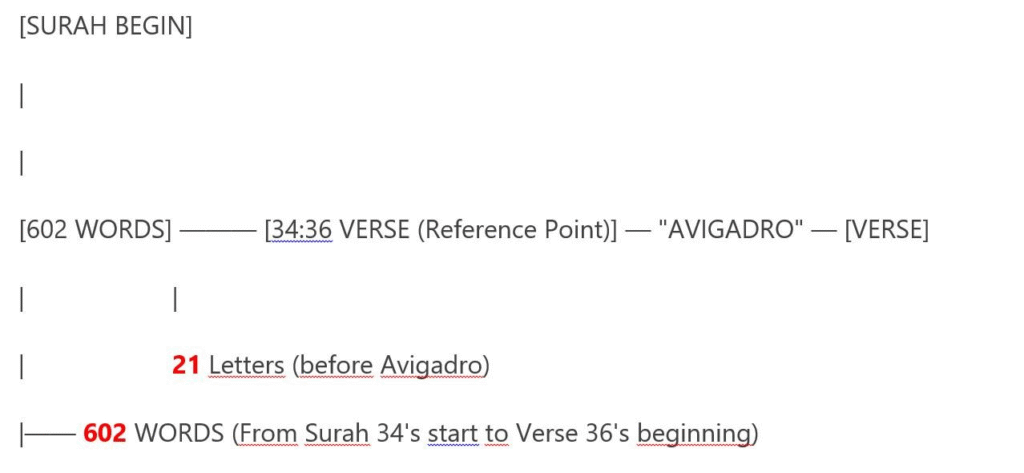

As clearly demonstrated, the sequence up to the letters “Avigadro/Avoigadro” forms a value of 602.21, which perfectly aligns with Avogadro’s constant when written with an exponent of 21, resulting in 602.21 × 10²¹ mol⁻¹.
The QURAN has remarkably indicated both:
- The decimal part (602.21)
- The exponent (21)
…simultaneously, by pointing to Avogadro‘s number with an exponent value of 21.
Avogadro’s Constant (Nₐ) – With Two-Digit Precision (602.21 × 10²¹ Format)
- Scientific Definition and Conversion:
NA=602.21 × 1023 mol-1
To express it on a 10²¹ basis, divide by 100 (10²):
NA=602.21 × 10²¹ mol-1
Visuals taken from the QURAN statistics program regarding the counts mentioned above are as follows:


An important observation here is as follows:
The verse containing the reference to Avogadro’s constant is found within Surah Saba (Sheba). In the Quran, the word “zerre” (meaning tiny particle/atom) appears exactly 6 times. Two of these occurrences are in Surah Saba, and two are in Surah Zilzal (The Earthquake). Therefore, it is logical to associate these two surahs with atoms or chemistry.
It is profoundly significant that Avogadro’s constant – one of the most important constants in chemistry – is specifically indicated in Surah Saba, which contains the word “tiny particle/atom/zerre” twice. Similarly, references to the Hiroshima atomic bomb also appear in Surah Saba and have been presented in the book. The two verses in Surah Saba containing the word “atom/zerre” are as follows:
34:3
وقال الذين كفروا لا تأتينا الساعة قل بلى وربي لتأتينكم علم الغيب لا
يعزب عنه مثقال ذرة في السموت ولا في الأرض ولا أصغر من ذلك ولا
أكبر إلا في كتب مبين
And nothing is hidden from your Lord [O Muhammad] of the weight of an atom (ذَرَّةٍ, zerrah) within the earth or in the heaven, nor what is smaller than that or greater than that, except that it is in a clear Book.
34:22
قل ادعوا الذين زعمتم من دون الله لا يملكون مثقال ذرة في السموت ولا
في الأرض وما لهم فيهما من شرك وما له منهم من ظهير
Say [O Muhammad], ‘Invoke those you claim [as gods] besides Allah. They do not possess [even] the weight of an atom (ذَرَّةٍ, zerrah) in the heavens or on the earth, nor do they have any partnership [in their creation], nor is there for Him from among them any assistant.’


This demonstrates that all verses in the Quran possess deep neural networks with:
- The surahs they reside within, and
- Other verses in those surahs.
Consequently, it can be said:
In the letter count of the QURAN, there is more than one cryptology and coding. When letters are counted by including the hamzas, very serious miracles are obtained; when they are counted without including the hamzas, very serious miracles can also be obtained. However, since a certain methodology is followed in this book, it is necessary to specify certain rules. Based on this, as a methodology in this book, hamzas have always been included in the count in analyses related to letter counting. Some explanations had already been made above regarding why the hamza should be counted from a grammatical perspective. When hamzas are not counted in the QURAN, the total letter count becomes 322,604. When hamzas are counted, the total letter count becomes 326,159. Since the counts in this book are made by including hamzas, the total letter count in the QURAN has been accepted as 326,159. Within the book, such precise values have been calculated – like the reduced Planck constant, the Boltzmann constant, ‘the cesium atom’s mass with a six-digit number’, and the ‘parsec length’ – that all these calculations prove that counting the hamza is correct. However, as also mentioned above, serious discoveries obtained by not counting the hamza also fall into the category of miracles. Just as there are different recitations (qira’at) in the reading of the QURAN, there is also more than one coding system in the counting analyses of the QURAN, and very serious results have been obtained with both methods.
All these explanations may have confused some people. Especially those who do not know Arabic may have felt overwhelmed by such technical details upon seeing them. To these people, we say:
Friends, believe that the details mentioned here are not complicated or difficult to understand. If you learn Arabic, understanding the details explained here will become very easy. Nevertheless, the reader might have thought something like this: ‘Isn’t there a miracle in the QURAN that is independent of recitations, independent of letter count, independent of word count?’ There will certainly be those who think, ‘Is there not a miracle that is unaffected by any recitation or any counting method?’ We would like to give good news to these people that there are also independent miracles in the QURAN that are unaffected by any variation (counting with hamza, counting without hamza, recitations, etc.). Some examples will be presented here for now; but there are other examples of this kind within the QURAN as well. The first of these examples to be presented, the Edwin Hubble letter sequence, was discovered by two QURAN researchers from Turkey named Tarık Taşpınar and Bülend Sungur. We truly congratulate them for this excellent finding and convey our thanks to them; because this discovery alone is sufficient evidence for a person to believe.
51:47
والسماء بنينها بأيد وإنا لموسعون
WE built the sky with ‘great power’ and indeed WE are (its) expander.
Normally, even someone with a basic knowledge of Arabic would easily understand that this verse speaks of the universe being expanded. Unfortunately, in the past, some exegetical scholars, due to the limited cosmological knowledge of their time, could not fully grasp the meaning of the sky’s expansion. Therefore, they interpreted the word in the verse not as “expansion” but as “power” or similar meanings. Note that it is said some exegetical scholars did not give the meaning of expansion; because some exegetical scholars did directly give the meaning of expansion. Normally, even someone with a basic knowledge of Arabic knows that the word used in the verse directly means “expansion.” Some atheists and deists object to this verse because some early scholars did not provide this meaning; but what they do not know is that ALLAH the MOST HIGH has placed the pronunciation of the name and surname of Edwin Hubble, the world-renowned person who proved the expansion of the universe, within this very verse. Therefore, no matter how many excuses atheists and deists search for, after such a sign, they have no objection left to make; because this miracle is more certain than the result of two times two being four.
As is known, the QURAN was written without vowel marks (ḥarakāt), and in later periods, diacritical marks (punctuation/vowelization marks) were added to the letters to prevent reading errors. When the verse is written without vowel marks, the name Edwin Hubble is encoded in Arabic letters in the following sequence:
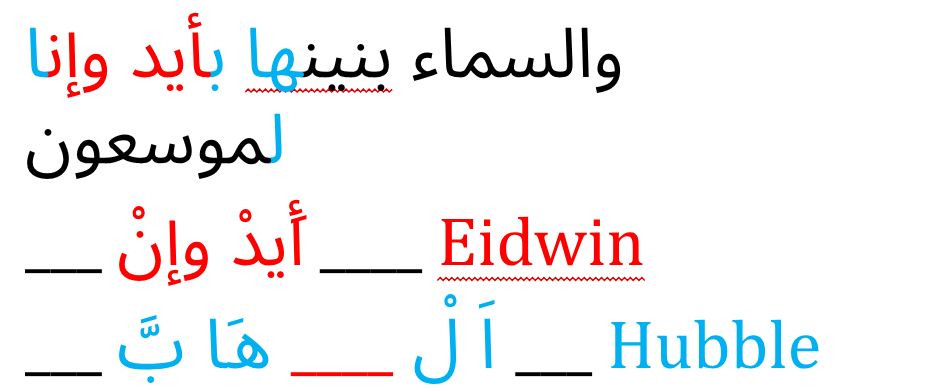
If the letters in the verse are pronounced with the vowel marks provided above, the exact sound “Edwin Hubble” is produced. Although languages are asymmetric, if the encoding of the name Edwin Hubble in this verse were represented in a latin language for it to be visualized in the minds of those who do not know Arabic, it would look something like this:

Note that the encoding of this name is based on its pronunciation. That is, the encoding is done through the letters pronounced when saying the name Edwin Hubble.
In the verse, the name Edwin is written within the name Hubble. Of course, it would not be logical to expect these two names to be consecutive; because if the letters of the name Edwin Hubble were to appear consecutively, the phrase would be read as Edwin Hubble. However, if the letters that form the name Edwin Hubble are written consecutively in Arabic letters, they would not convey any meaning. The QURAN has encoded the letters of the name Edwin Hubble with perfect literary artistry, interweaving them in such a way that both the names Edwin and Hubble are encoded, and at the same time, the verse in Arabic expresses a profound meaning like the expansion of the universe. This encoding simply compels one to prostrate. There are similar encodings elsewhere in the QURAN.

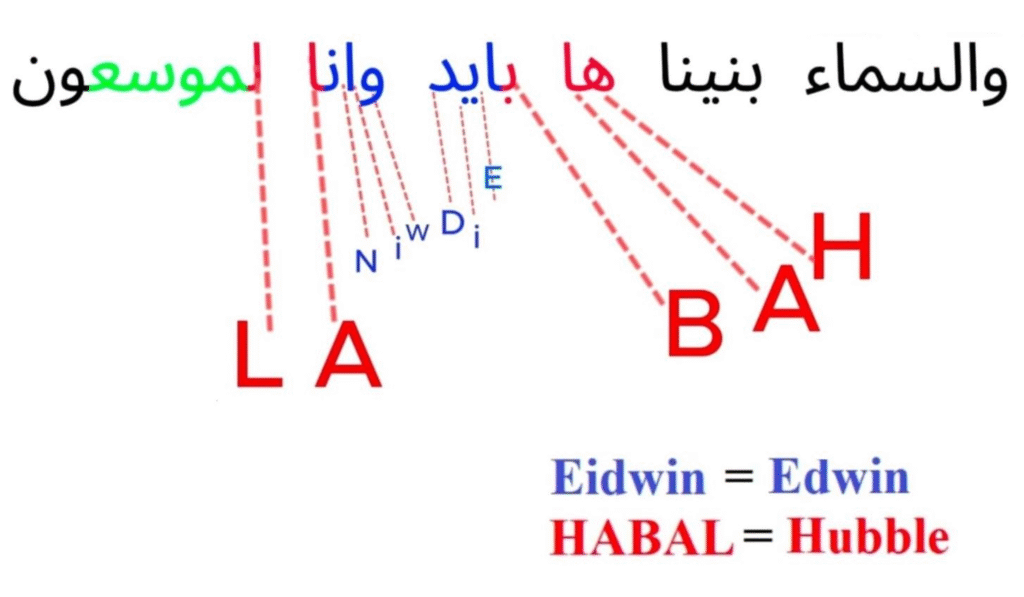
As can be seen, no matter which recitation (qira’at) or which counting method is used to investigate this miracle, the result does not change. The verse explicitly speaks of the expansion of the universe, and within the same verse, the name and surname of the person who played the most important role in the discovery and proof of the universe’s expansion are encoded with a perfect sequence. Although encoding (transliterating) proper names in other languages is quite difficult, the QURAN has encoded these two names very clearly and distinctly. Therefore, the fact that a verse from 14 centuries ago speaks of the expansion of the universe and also encodes the name and surname of the person who would prove this expansion shows that the QURAN can never and ever be human made. Rather, it can only be the WORD of ALLAH the MOST HIGH, who knows all times and possesses infinite knowledge. A Muslim can confidently challenge all atheists, deists, and other non-believers with such a miracle. No non-believer can or will ever find a sentence in a book written centuries ago that speaks of the expansion of the universe and, moreover, discover the sequence of the letters “Edwin Hubble” within that sentence. This is the uniqueness of the QURAN. Even if all humans and jinn were to come together, they could not produce the like of even a single chapter of the QURAN.
Here, some of the wisdoms behind choosing the Arabic language as the language of the QURAN are better understood. Because the Arabic language is written without vowel marks, it is possible for a word to convey a meaning in Arabic while simultaneously encoding another word. In the example of Edwin Hubble, the verse expresses certain meanings in Arabic while also encoding the name “Edwin Hubble.” The name Edwin Hubble can be written differently in modern Arabic orthography; however, the sequence of letters given consecutively in the verse can easily be read as “Edwin Hubble” within the rules of Arabic.
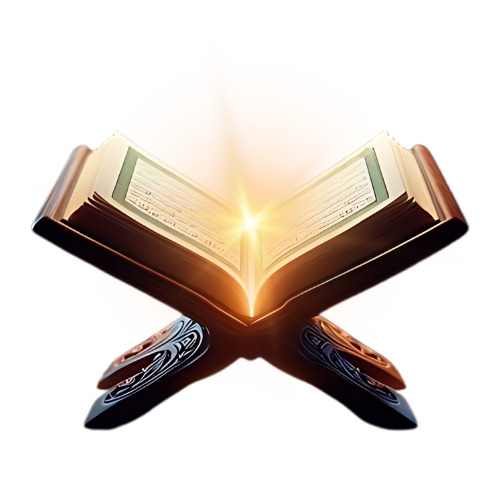

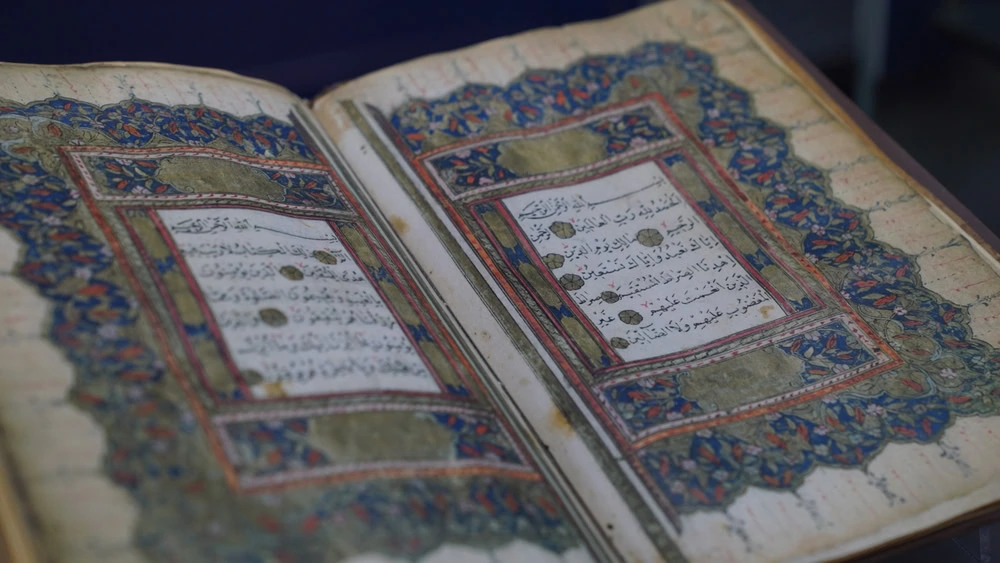





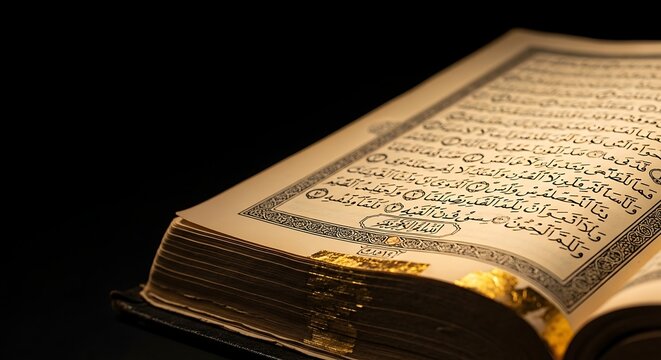

Leave a Reply